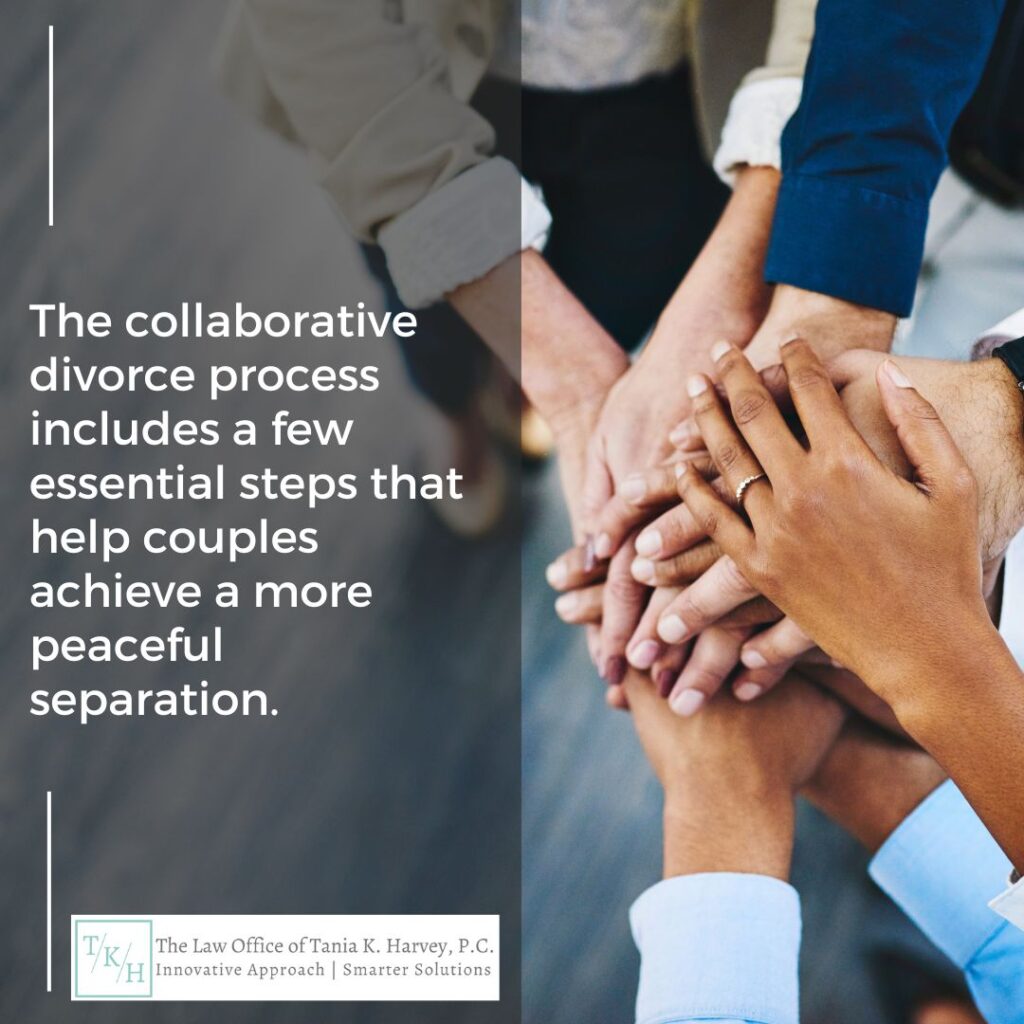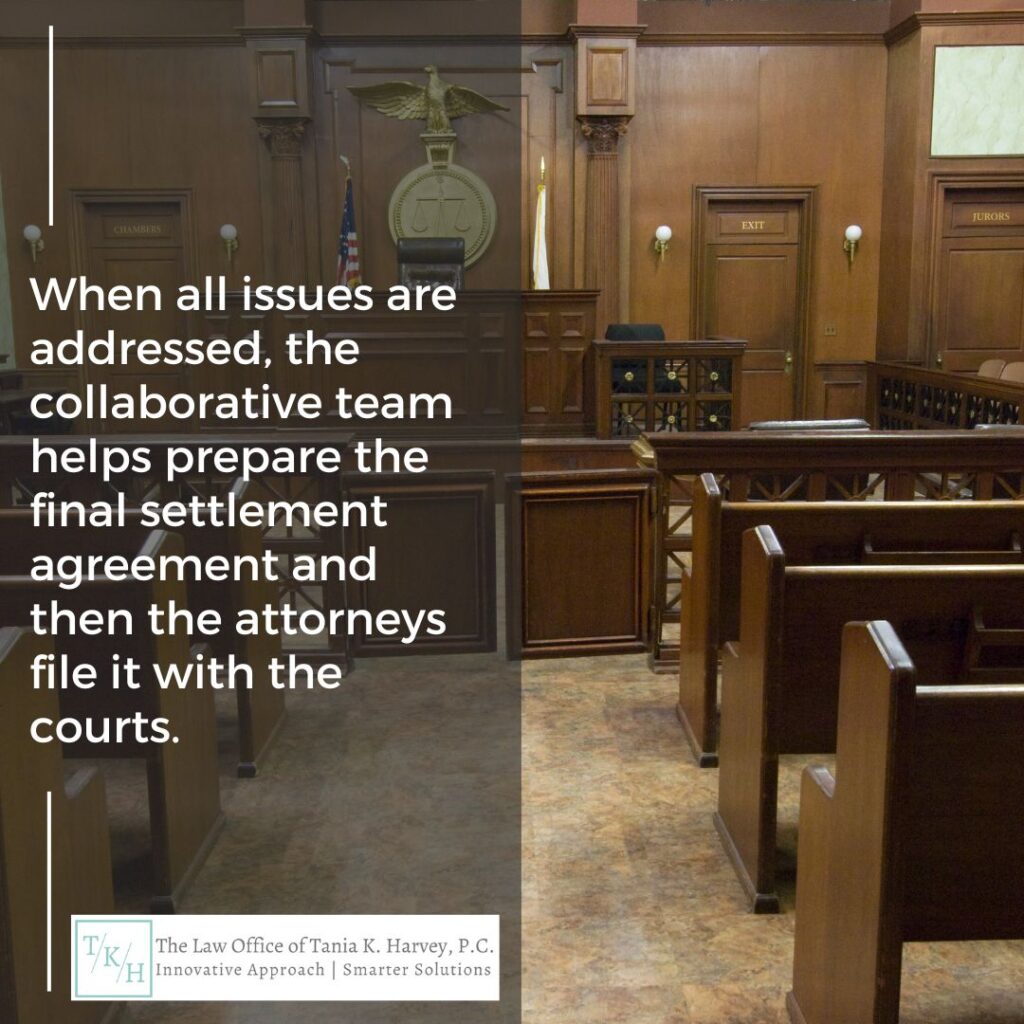Divorce is a challenging and emotionally taxing process, but collaborative divorce offers a more amicable alternative to traditional litigation. At The Law Office of Tania K. Harvey, our divorce lawyer Wheaton takes and innovative approach to family law focuses on collaboration and mediation. The ugly and bitter divorces or custody cases that you have heard about, where clients and lawyers engage in vindictive and vengeful tactics, are being transformed. To request a free consultation call 312-803-5845 today.
In a collaborative divorce, couples work together to resolve their differences, with the support of trained professionals. In this article, we present a step-by-step guide to the collaborative divorce process, shedding light on its benefits, requirements, and how it helps couples achieve a more peaceful separation.
Step 1: Choosing the Collaborative Approach
The first step in the collaborative divorce process is both parties’ decision to choose this alternative method. Collaborative divorce requires commitment from both individuals to work together transparently and respectfully. Statistics show that couples who opt for collaborative divorce are more likely to reach a mutually acceptable settlement than those who pursue traditional litigation. According to a study published in the Journal of Family Issues, collaborative divorce results in negotiated settlements in more than 85% of cases.
Step 2: Assembling the Collaborative Team
Collaborative divorce involves a team of professionals specializing in different areas who work together to facilitate the process. This team typically includes attorneys trained in collaborative law, a financial expert, and a mental health professional. Each professional has a specific role, ensuring a comprehensive approach to resolving legal, financial, and emotional aspects of the divorce.
It is really important, if you are interested in collaborative divorce, to have someone that is actually trained in the collaborative process. There are many attorneys who say they will utilize collaborative divorce, but who do not have the credentials to back it up. At The Law Office of Tania K. Harvey, our divorce lawyer Wheaton has met the requirements as a collaborative divorce attorney and will make sure your process is efficient and amicable.
Step 3: Initial Meetings and Disclosure of Information
In the initial meetings, both parties and their attorneys meet to define the ground rules and set goals for the collaborative divorce process. They establish the framework for respectful communication and cooperation, ensuring that both individuals actively participate in finding solutions. During this phase, each party discloses all relevant financial and personal information transparently. Open and honest disclosure is crucial for trust-building and helps prevent surprises or hidden agendas later in the process.



Step 4: Joint Problem-Solving and Negotiation
The collaborative team employs various techniques, such as joint meetings and negotiation sessions, to address the issues at hand. These sessions provide a safe space for open communication, where individuals express their concerns and work towards mutually beneficial solutions. Unlike litigation, collaborative divorce encourages problem-solving rather than adversarial battles.
Financial matters play a significant role in divorce, and collaborative divorce utilizes the expertise of financial professionals to ensure fairness and objective analysis. Financial experts help identify and value marital assets, assess income and expenses, and develop sound financial plans for both parties. Their input provides clarity and objectivity, enabling couples to make informed decisions regarding property division, child support, and spousal maintenance.
Forbes notes that neutral professionals make it easier to talk through things and consider the overall welfare of everyone involved. That way, agreed upon outcomes meet everyone’s needs. Are divorce lawyer Wheaton will make sure that everyone involved works towards meeting your goals.
Step 5: Drafting the Collaborative Settlement Agreement:
Once all issues are addressed and a resolution is reached, the collaborative team helps prepare the final settlement agreement. This document outlines the agreed-upon terms and serves as a blueprint for the divorce judgment. The collaborative settlement agreement is then filed with the court to formalize the divorce process.
Our divorce lawyer Wheaton will make sure the collaborate process goes smoothly for all parties involved
The collaborative divorce process offers couples a respectful and cooperative path to creating a mutually acceptable divorce agreement. By choosing collaboration over adversarial litigation, couples can reduce both financial and emotional stress. The step-by-step guide outlined in this article demonstrates the structured nature of the collaborative divorce process and highlights its potential for successful resolution.
Collaborative divorce statistics consistently show higher rates of satisfaction, negotiated settlements, and reduced post-divorce conflicts, making it a compelling choice for couples seeking an amicable separation.
If you are considering divorce, exploring the collaborative divorce process with the assistance of our divorce lawyer Wheaton can help you navigate the complexities and achieve a more peaceful resolution.

